#( ; gwyneth is still the love of my life but i wanted to risk a little change. )
Text



after a few days of secretly thinking between three precious human beings, bridget regan is pepper's new fc.
#( ; gwyneth is still the love of my life but i wanted to risk a little change. )#( ; i initially wanted to change victoria's but cant do it. )#( ; so i'm changing peps. )#( ; now i demand threads pls send pepper things. )#( ; i will give you candy. )#( ;; ooc. )#( ;; psa. )#( ;; WHO’S THE HOT MESS NOW? / pepper potts / VISAGE. )
4 notes
·
View notes
Text
The Not-So-Amazing Mary Jane Part 30: AMJ #4.2

Previous Part
Next Part
Master Post
This post is something of an exception in my coverage of AMJ. Originally I hoped to dedicate just one post per issue but changed that to two due to the length. The pages I’ll be covering here though are exceptional.
Not just because I had so much to say about them, but because they cut to the heart of the story. These pages present Williams’ attempt to finally justify MJ’s actions throughout the story. As such I’ve opted to single these pages out in this instalment and continue covering the rest of the story next time.
If you want the context for the preceding pages check out the previous post.
The pages revolve around MJ chatting with Master Matrix. It turns out he knows ‘McKnight’ is really Quentin Beck. She thanks him for keeping their secret. Master Matrix asks MJ how Spider-Man feels about her working with Mysterio; I guess he knows about her connection to Peter too.
MJ gets a little flustered by this question. MM continues that he’s questioned how to raise this subject with Spidey himself. MJ relates to this and explains that Peter knows she’s working on a Mysterio movie, just not with the man himself. MM asks why she’s deceiving Peter. MJ explains she isn’t being deceitful on purpose (um…yeah she is) but is just protecting Beck because she believes in what he is doing.
MM makes the (incredibly obvious) point that Mysterio is a villain and Spidey is good. He elaborates that they are both hiding the truth from a good person to collaborate with a villain. MJ responds by asking if MM understands the concept of redemption. He says he does.
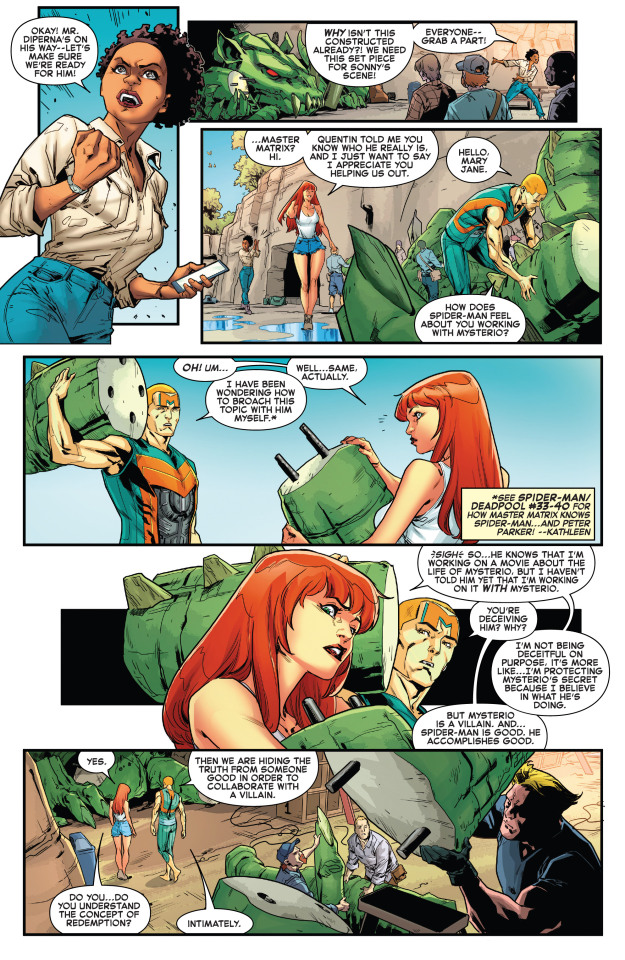
Lord have mercy, this page is awful.
Now I should be upfront. I didn’t read Spider-Man/Deadpool so maybe I need to be set straight about certain important details from that title. I don’t know how or why Master Matrix knows who Spider-Man is for example. My brief research tells me he was rescued by Peter’s parents or something. I don’t recall seeing anything about Mysterio when I read up on him, so I don’t know how or why he’d know ‘McKnight’ is really Beck. Maybe his abilities allow for him to deduce that fact? If not, then that’s yet another hole in the story.
Anyway, the point is he knows Peter is Spider-Man, keeps in contact with him and by extension knows about (or has deduced) MJ’s connection to Peter. What’s less clear is how Mary Jane knows about MM’s connection to Peter. We’ve never seen them talk about him or any of Peter’s adventures with Deadpool for that matter.
I’m willing to accept that personally I guess. As I went over in parts 3-5, Peter does clue MJ into major events in his Spidey career. I suppose befriending a living Weapon of Mass Destruction would count as something your partner ought to know about. This ultimately hurts Williams’ own narrative though. It demonstrates that Peter has been very honest and open with MJ whilst she hasn’t. It also further proves that Peter would inform MJ of his hero career, which would include Beck and his past crimes. Therefore MJ would very likely know about all the stuff Beck did in ‘Guardian Devil’ and just about everything else we discussed in parts 3-5. And yet, she’s still getting chummy with a murderous, sexually violating monster.
We then come to the lame-ass attempt by Williams to address MJ’s motivations for this arc. First of all, Williams thinks now this is the best time to address that elephant in the room? It’s the penultimate issue of the arc (originally the entire series)! This shouldn’t been pinned down by issue #1 or #2 at the absolute latest.
Lateness aside, Williams’ attempt (unsurprisingly) utterly fails. MJ comes off almost childish when she says she isn’t ‘being deceitful on purpose’. A quick look at the definition of deceit proves that to be bullshit.
It’s the equivalent of saying “I’m not lying. I just happen to be withholding certain truths.”
Yeah that’s lying by omission, which is a form of deceit!
As for her justification for deceiving Peter, I’ve gone over that more than enough. MJ wouldn’t believe in what Beck is doing. Or at least she never would to the point where she’d lie to Peter the way she is or protect a terrible person like Beck.
The audacity of Williams to bring up how MJ is protecting a villain and deceiving a hero is unbelievable. It’s honestly left me flabbergasted. So, Williams KNOWS that’s what she’s written MJ as doing? She KNOWS that but she’s still having MJ do it? Or is she really just incredibly unaware and paying lip-service?
Maybe the next page will enlighten us.
So MJ just asked if MM understands redemption, which he does intimately. She follows up by saying he’d understand then that it’s not a simple switch from bad to good. Rather, it’s a journey that takes a lot of work; work Beck is putting in right now. MJ feels she is protecting Beck’s ‘journey’. It isn’t that she thinks Peter incapable of understanding this (quite the contrary), she just hasn’t figured out how to tell him. She doesn’t want him to worry about her and feels he is already got enough on his mind.
MM then asks what if MJ has misjudged Beck? To this she concedes she will have deceived Pete, which makes her feel sick.
MM then reveals he was created as a WMD and that he is sure Beck knows tha. He elaborates that when Beck approached him, he presumed it was for the sake of efficiency. However, now he realises it’s because Beck wanted to give him the chance to make something meaningful. In this sense Beck has used his own journey of redemption to protect MM’s own. MM feels utterly indebted to Beck for this.
MJ responds that all MM can do is earn that debt in reverse.
Meanwhile, Diperna has arrived. Screwball has been harassing the journalist with her drones this entire time and continues to do so out of pure fun.
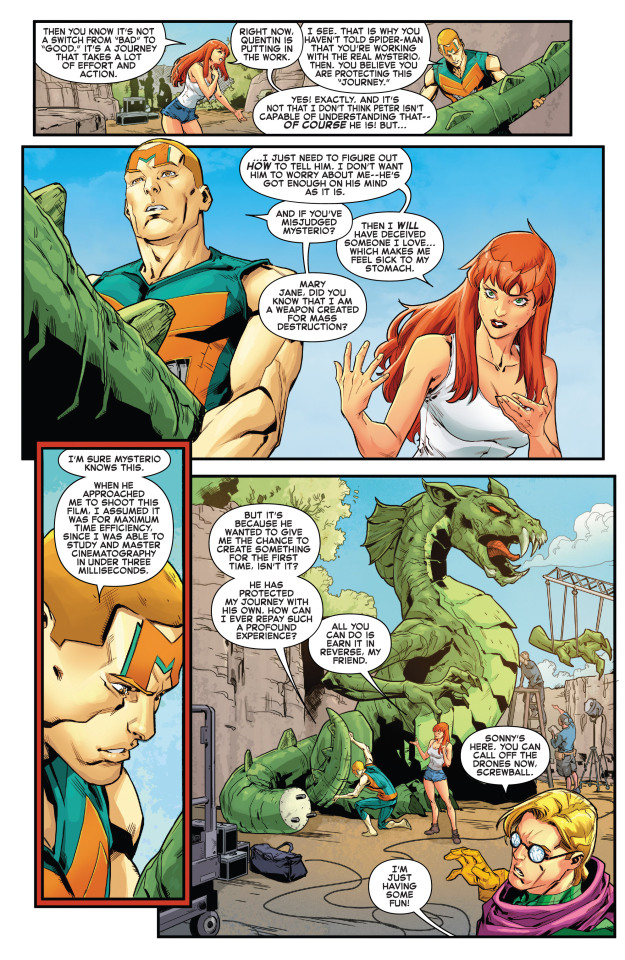
Jesus Christ where to start with this.
MJ is correct that a journey of redemption is more than just a switch from bad to good. It is indeed a long hard journey.
But as I’ve illustrated in parts 9-11, MJ wouldn’t extend the possibility of redemption to Beck given what she knows about him. His actions in this story so far do not reflect someone who’s ‘putting the work in’ at all. He’s evaded the law, broken (and is still breaking) numerous laws to get to this point and shows no signs that he’s going to face the music for his crimes. He’s not even attempted to make amends to the people he’s wronged beyond his old flame Betsy. His attempt with her has been mutated due to MJ to the point where it’s hardly what Beck intended in the first place. Even if it was his ‘apology’ to Betsy would’ve amounted to making her look cool and sexy which by extension glorified himself. Every one of his attempts to help people like Master Matrix have ultimately benefitted himself.
The closest he’s come to honest self-sacrifice, of doing something good purely for the sake of others, was fighting the Savage Six last issue. But even that was selfish to a point. He had personal beef with the Vulture. They were trashing his movie. In defeating them and protecting his staff he was in turn aiding the protection of his life’s work. In contrast, I detailed several instances in part 10 where criminals put themselves on the line to help people selflessly. Boomerang, Black Cat, Sandman, Venom. All of those people risked their freedom and/or their health for Spidey, for innocents or for the grater good.
Beck hasn’t done that yet. Everything he’s done, even if it has protected innocent people, has simultaneously served his own materialistic or egotistical goals. Hell, given the ease with which he dealt with the Six, it barely qualifies as putting himself at risk.
Extending a helping hand to people like himself is not grounds for putting the work in. He’s helping other criminal/dangerous people make something meaningful. So what? Will he be donating the money to the loved ones of the people he’s hurt? Or to the people thsmselves? Is he going to create a trust fund for Gwyneth’s baby? We know he isn’t going to apologise for his evil actions though the film because MJ said so back in issue #1.

MJ is protecting a murderer, a mental abuser, a sexual abuser and a generally horrible person. Someone who wants forgiveness but has not actually demonstrated anything in the way of repentance for his actions. As AMJ laid out, he wants to be forgiven by making everyone understand who he is and why he did what he did.
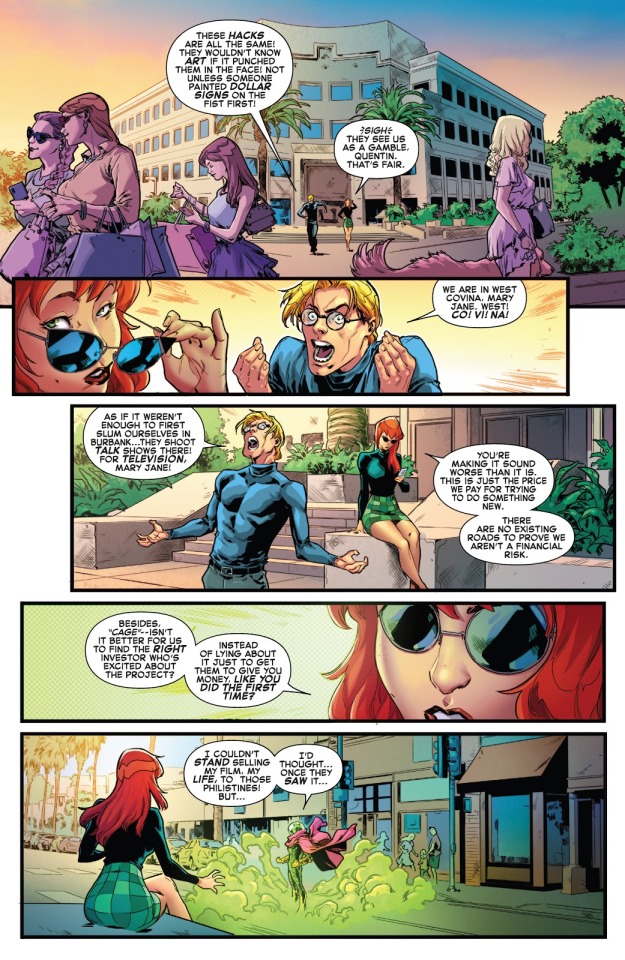
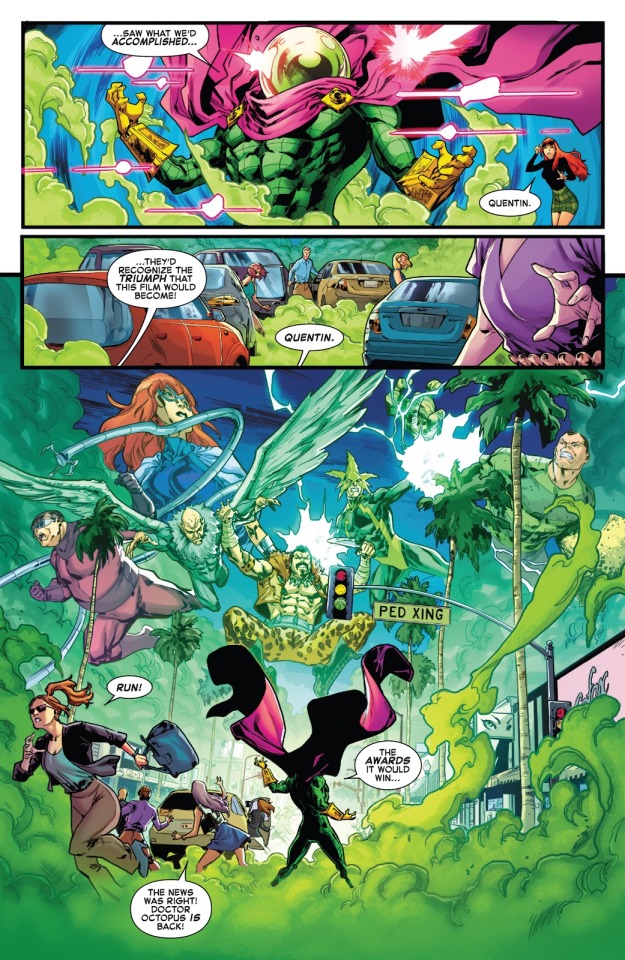
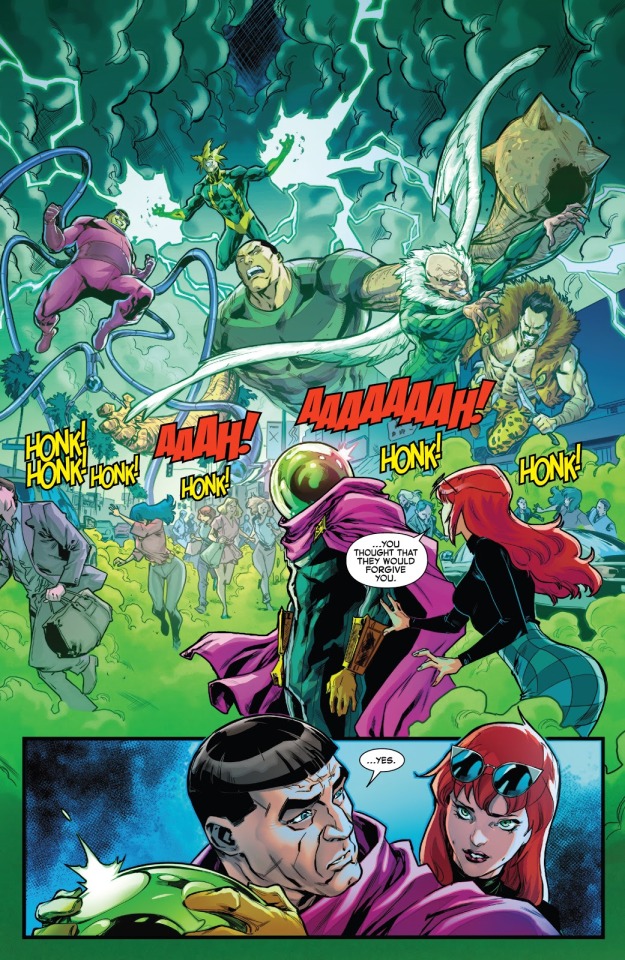
He (and seemingly MJ and Williams) is confusing understanding with justifying. We can understand how and why people did something bad. That’s very different to justifying it and thereby forgiving them.
Even in the over simplistic good/evil world of super hero comic books this is simply not how redemption works. In addition to the examples I listed in part 10 let’s consider an example from a comic book movie.
Maybe you’ve heard of it, it’s called ‘Spider-Man’ from 2002.
In the film a guy named Peter Parker confronts the man he believes murdered his uncle, the man who raised him. The criminal is scared but not apologetic for what he’s done, and he asks to be given a chance. Peter’s response is.
What about my uncle? Did you give him a chance?
youtube
We can very much apply this to AMJ. Beck wants a chance, MJ is giving him that chance. So I ask:
What about Gwyneth?
What about her parents?
What about her baby?
What about the families of the seniors Beck swindled?
What about the real Cage McKnight’s reputation?
What about all the people terrified by Beck’s tantrum in AMJ #2?
What about all the people Screwball or Kangaroo have hurt?
What about Dr. Winhorst?
What about all the people and all the animals harmed or killed when Doc Ock heated up half the globe?
What about all the people scared or hurt when he faked an alien invasion in ASM v5 #1?
Did Beck ever even hint he gave any of them the slightest chance?
No. He didn’t.
For God’s sake, a terrible story like ‘Venom: Lethal Protector’ wasn’t as naïve or childish as this story. Venom is called out for murdering a man’s son. He acknowledges this but tries to argue he didn’t mean to kill him. The story though doesn’t let him off the hook for it.
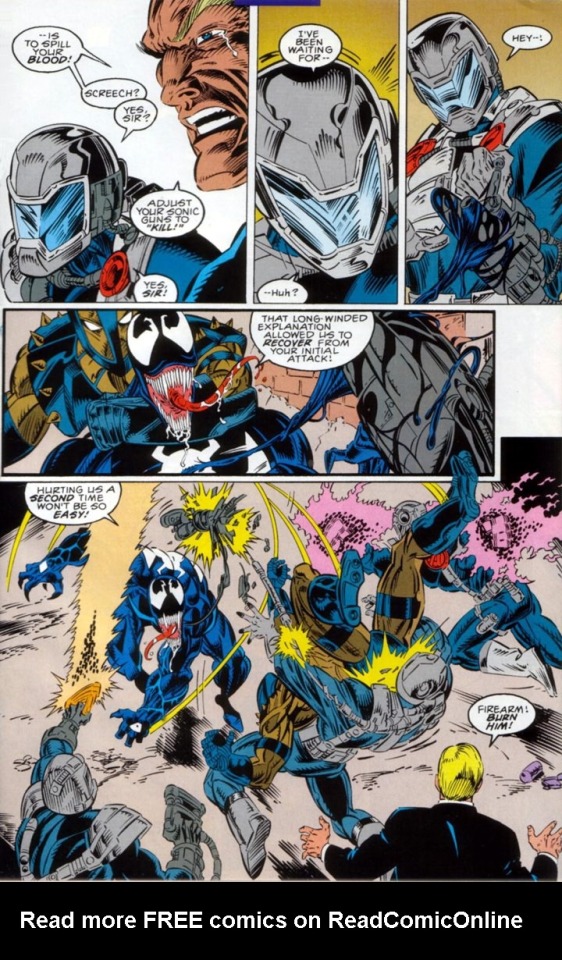
If a 1990s Venom mini-series can acknowledge a homicidal maniac shouldn’t be given a chance just because he’s sorry, then why the Hell can’t this story?
There is another great non-comic book example that illustrates this point. It comes from the Doctor Who episode ‘Boom Town’. Whilst not a comic book or superhero story, Doctor Who is often regarded as a cousin of sorts to the former. Marvel even made Doctor Who comics for a long time.
In the episode in question, the Doctor shares a ‘last meal’ with an alien criminal whom he intends to hand over to the authorities.
She is guilty of murder, attempted genocide and fraud and identity theft in the vein of Beck; although she is literally wearing the skin of the person she’s impersonating. To gain the Doctor’s mercy she tries to prove she’s changed, specifically by explaining a time she spared a life. Earlier that day she readied herself to kill a young journalist sniffing around her plans, but refrained upon learning she was pregnant.
The Doctor believes the story but is totally unconvinced. He explains it doesn’t mean anything. Every now and then terrible people on a whim happen to be kind and spare their would-be victims. It’s how they live with themselves.
youtube
Whilst Mysterio is probably nowhere near as bad as the alien criminal, his case for forgiveness is arguably worse.
He’s continuing to steal the real Cage McKnight’s identity, he has never indicated he’s going to continue to help people after the film is completed. He caused panic and would’ve caused harm had a third party (MJ) not intervened to keep him under control. And his equivalent of sparing a life amounts to giving other criminals the chance to help realize his personal vanity project.
Not to mention, MJ and Beck continuously insist upon the movie being something meaningful but how could they possibly know that. A movie isn’t meaningful just because it means something to the film makers. The audience decides if it’s meaningful or not. Frankly Beck’s insistence he’s giving his staff the chance to make something good and meaningful is egotistical. As though the mere act of film making or his own life story is inherently something with artistic merit or something meaningful in the universe.
Yes, some films are. But even then their ability to do something helpful and positive is relatively limited. A piece of media’s practical abilities to positively contribute to the universe is limited compared to say, donating time or money to the needy. At least there you would’ve done something with a definitive impact even if it was a small one. A movie like this might illicit emotions and make some people feel happy, might inspire them to do good, might make them understand themselves or another better. But the key words there are ‘might’ and ‘maybe’.
When you get right down to it, even the most influential movies don’t positively contribute helping people as much as individuals actually actively doing stuff to help others. I mean are we really going to say the ‘Black Panther’ film had as much of a positive impact as the Civil Right Movement?
Absolutely not.
Let’s use a fictional example. Would the stage play about the Fantastic Four (as seen in ASM v5 #25) have been as meaningful as the efforts of the actual Fantastic Four in fighting Galactus?
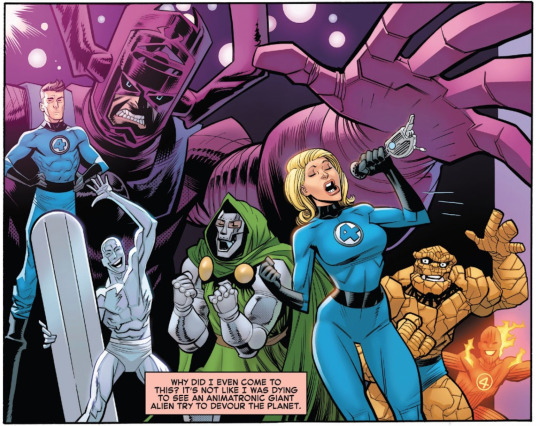
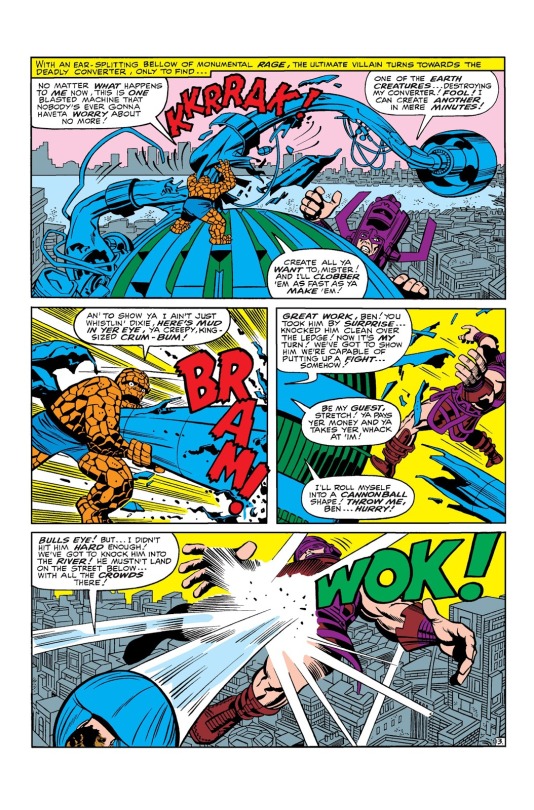
Absolutely not.
I’m not saying films don’t matter or can’t have a meaningful positive impact. I’m just saying if Beck wanted to achieve the latter, there were better options than making a film about himself.
He could’ve donated his ill-gotten gains to needy communities. Or handed over his technology and techniques to the public? Or used his skills to expose white-collar criminals? Or even have started up a company selling his technology and employing criminals semi-legally reducing the need for them to resort to crime.
But he didn’t. He’s fulfilling his own personal dream and making himself centre stage.
As for MJ lying to Peter because she doesn’t want him to worry and has his own problems, see parts 17-18 for why that’s bullshit. And see parts 19-23 for why Peter, and MJ herself, should be worried about her in this situation. And that was before the Savage Six made them a target, a fact that should have resulted in Peter already being worried.
Hypothetically even if this wasn’t something to worry about, MJ could be open about it with Peter and convince him to relax. He begrudgingly accepted her staying with him during Marvel Knights in spite of the dangers to herself.

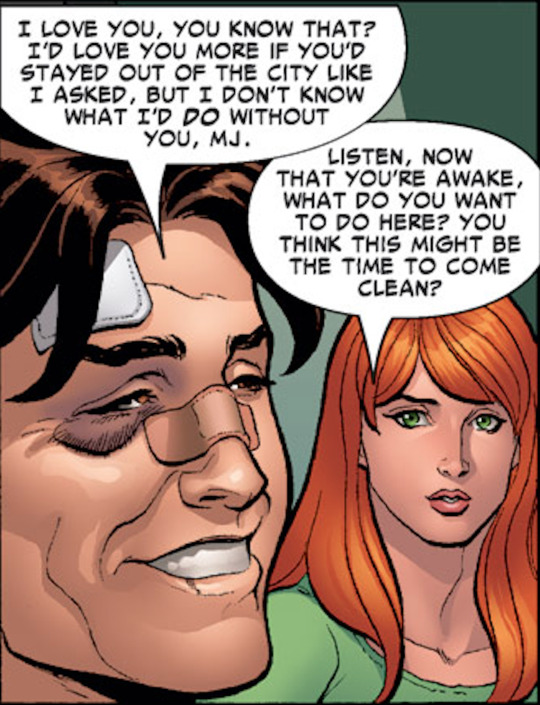
She equally made him see sense in ‘Parallel Lives’ after their home had just been attacked.

Whilst this situation is something to be concerned about, if MJ was in fact in no danger, then she could talk Peter around to trusting her.
I’ll also add she’s had plenty of time to figure out ‘how to tell him’ the truth. She knows he’s living with Boomerang so right there that’s a potential route to breaking in the conversation. She could bring up Venom, or Sandman or Felicia. There are multiple people they’ve mutually given chances to that could be used as a way to engage with Peter on this topic. By this comic’s own brand of ‘logic’ those are perfectly viable arguments MJ could use.
Don’t get me wrong. Those are false equivalencies. But I’m just saying Williams’ clearly doesn’t think this situation is any different to those ones, therefore there are plenty of grounds for MJ to talk to Peter about this. She even has MJ say ‘of course’ Peter would understand.
It’s almost like Williams knows that this situation cannot actually be justified. Or she’s injecting contrived false drama for the sake of drama with no mind paid to established characterization.
Hence we get trite like MJ saying she ‘will have deceived’ Peter if she’s wrong about Mysterio. First of all, Williams is again acknowledging how asinine her narrative is. She’s acknowledging that MJ is gambling that her judgement of Beck is on point. Her judgement of a guy who’s power set revolves around misdirection. Second of all, MJ wouldn’t have deceived Peter if she’s wrong. She’s already deceived him and is continuing to do so. Thirdly why exactly does Mary Jane get to be the singular person deciding if it is okay to gamble on Beck’s redemption? Who is she exactly to decide if this murderer and abuser is worth keeping out of jail?
In the real world if such a risk is taken it doesn’t ride upon one person’s decision; at least not in theory.
Let’s move onto Master Matrix. Again, I don’t know enough about him to discuss Beck’s knowledge of him. Maybe it makes sense, or maybe it’s a big question that’s being left unanswered. Regardless, I detest framing Beck as this selfless redeemer through Master Matrix’s subplot. I hate it almost as much as I hate the nonsensical dialogue that follows it.
What the fuck does ‘earning it in reverse’ even mean? I guess it means living up to Beck’s trust? But then why not phrase it that way? Even if that was the intent, see above for why giving MM a chance doesn’t really mean anything. Not to mention, both MM and MJ are just kind of presuming that Beck was in fact being altruistic.
That’s all for now. We’ll resume coverage of the rest of the issue next time.
Previous Part
Next Part
Master Post
#Leah Williams#Carlos Gomez#Amazing Mary Jane#mjwatsonedit#mary jane watson#Mary Jane Watson Parker#MJ Watson#Mysterio#Quentin Beck#Spider-Man#Peter Parker#Black Panther#Venom#Eddie Brock#Venom Symbiote#Black Panther 2018#MCU#marvel cinematic universe#Doctor Who#Spider-Man 2002#Spider-Man the Movie#Galactus#Fantastic Four#the fantastic four#fantastic 4#The Fantastic 4
12 notes
·
View notes
Note
Okay, I saw the tag on your recent post...I want to know your top Met looks of all time!
SCREEEEEECH THIS IS THE MOST IMPORTANT POST OF MY LIFE THANK YOU.
Disclaimer: I have to divide this into “awards” otherwise I will die trying to choose. Hahaha.
Disclaimer 2: Cole and Lili are obviously up there for me, but I’m gonna leave them out for the sake of this countdown.
1. Weird and Wonderful: Solange, 2015.
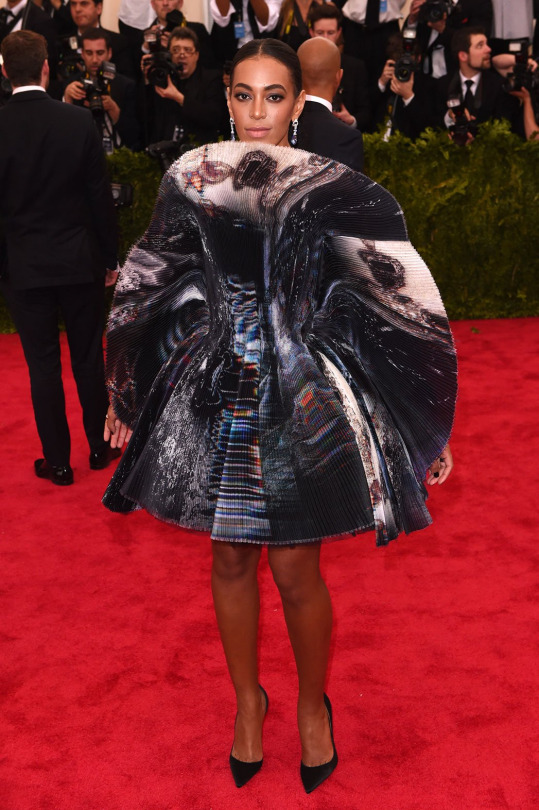
Solange and Rihanna have been in constant competition these past few years for the Met Gala MVP (with Zendaya now arguably poised to pip them at the post). Rihanna is forever my girl, and she will always get all the accolades, but while she’s a chart-topping single, Solange is a jazz suite - intricate and elaborate and complex and a little odd. She’s not afraid of leaning into the weird, in fact she thrives on it, and this structural Giles dress is a great example of that.
2. Vintage Icon: SJP and Alexander Mcqueen, 2006
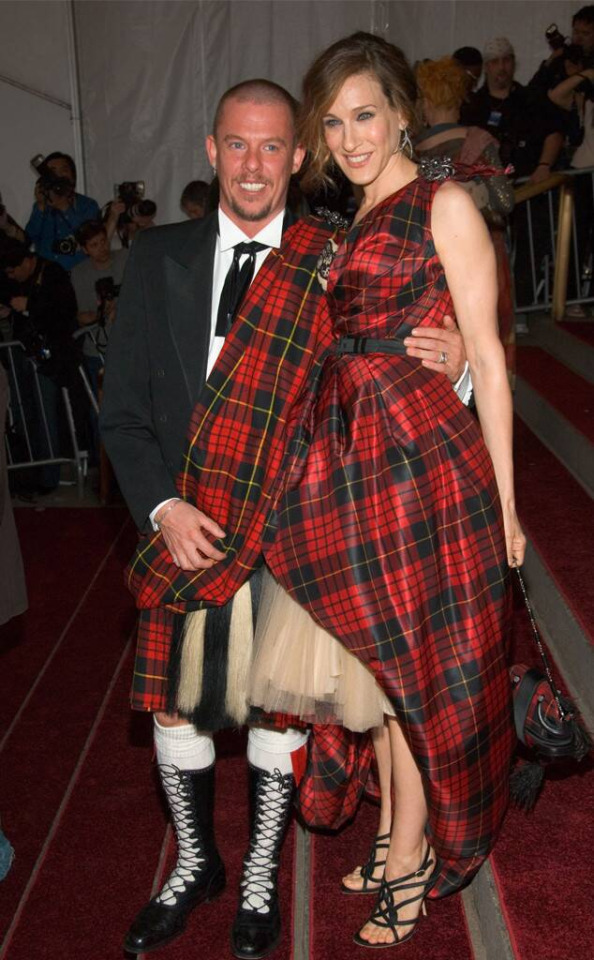
Look. As much as I love SH, I don’t know if any pair could top this combination of pure star power: Sarah Jessica Parker and the late, great Alexander Mcqueen. Please, please, please research Mcqueen if you can. Please look up his impact on fashion, and SJP’s, and see why this was the perfect storm. More than a look, this was a moment.
3. Princess Moment: Claire Danes, 2016.

Look. This is just picking a straight-up winner and I’m not even embarrassed about it. I gasped when this made its debut on the carpet. Posen’s signature pleats and drapes set off the shimmery tech perfectly, and it was just a beautiful way to show off Claire Danes while Homeland was still having a moment. Insanely stunning.
4. Best Male: Chadwick Boseman, 2018
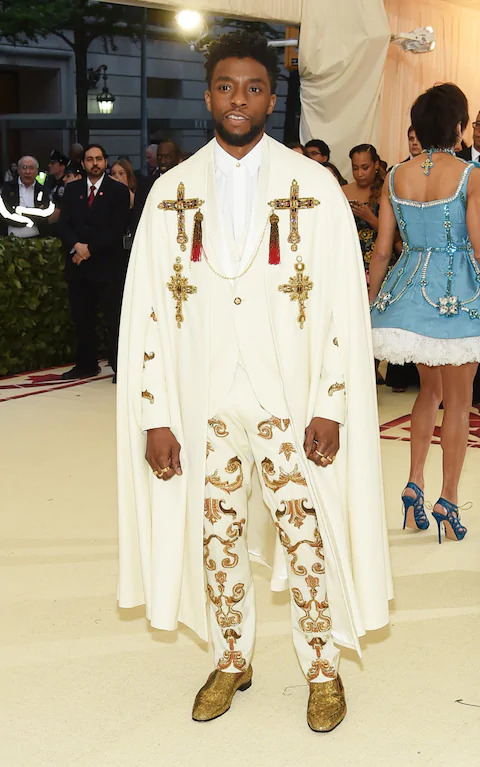
My love for Chadwick is well-documented on this blog. I nearly cried over this last year, because it was just so perfect - the culmination of Black Panther’s dream run and a playful, brilliant take that was, sure, a little on-the-nose but a wonderful sign for men’s fashion. Chadwick’s outfit is like, hey, we sure as hell can have fun, too. This makes me really look forward to what the men have in store this year!
5. On Theme But Super Pretty: Sienna Miller, 2013

Keeping in mind that this was the year that Gwyneth Paltrow turned up in a stupid freaking PINK DRESS for a PUNK-THEMED GALA, I remember having such affection for this look because it was just so effortless, requiring no backbending to fit into theme. Just look at it - it’s punk princess turns up to the Met. That’s it. Nothing takes away from the gloriousness of that jacket, but everything somehow adds to it. This gets prettier every year that I look back at it.
6. Shutting It Down: Rihanna, 2015
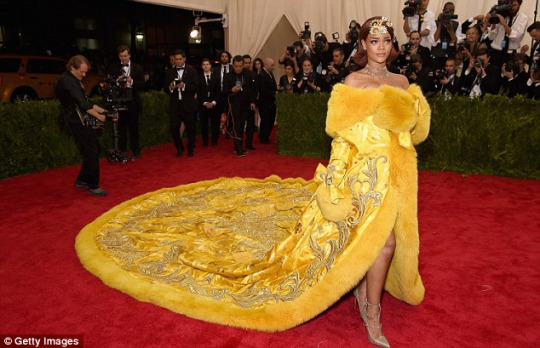
The year was 2015. None of us had any idea that we would soon be surrendering all of our hard-earned money to the sportswear, beauty and lingerie empire of FENTY. Rihanna hadn’t realised “ANTI” yet, arguably her best album ever. She was an emerging force in fashion, but it wasn’t until her 2014 CFDA Swarovski-only outfit that we all kinda thought, oh okay, Robyn, hey.
Then THIS knocked it out of the park.
Consider the logistics: this thing took TWO years to create by hand. Everyone else went for the tired Eastern cliches at the “China: Through The Looking Glass” Gala but Rihanna did her research, sought Guo Pei out and wore this and forever changed the Met. Yes, it was memed endlessly, but that’s the point. The Met should start conversations about fashion, not fill up some ho-hum “Who Wore It Best” column in OK! Magazine. It was ridiculous and luxurious and a total risk, and it paid off. Undoubtedly my top Met outfit of all time.
45 notes
·
View notes
Link
Emilia Clarke's Short Hairstyles and Haircuts - 15+ - https://shorthaircutsmodels.com/emilia-clarkes-short-hairstyles-and-haircuts/ - Emilia Clarke's Short Hairstyles and Haircuts, showed off her new cut by stylist Jenny Cho on Instagram confirming that the new short style was actually meant to look like matching fairies Pitt and Paltrow had when they dated. The eighth and final season of Game Of Thrones is still a good eight or more months away but that hasn't stopped Emilia Clarke aka Daenerys Targaryen aka Mother of Dragons from making headlines in. Emilia Clarke's Short Hairstyles and Haircuts Emilia Clarke's Short Hairstyles and Haircuts, The meantime. At first Clarke's GoT lowkey admitted dyeing her hair blonde for her destruction and then making fans cry by getting her dragon baby tattoo on her wrist everywhere. And now she has made another move. Clarke has cut her hair into a short itty bitty pixie cut that makes her look almost completely unrecognisable. Clarke's new haircut was first seen wearing a. Emilia Clarke's Short Hairstyles Emilia Clarke's Short Hairstyles and Haircuts, Blazer gold hoops and jeans at the Florence + The Machine concert at The Hollywood Bowl in California last night. As noted, Clarke has been photographed in the same blazer as the late Emerald on more than one occasion, including an Instagram photo of his tattoo but don't be fooled. his haircut is completely new and insanely gorgeous. Changing your hairstyle thick or thin. Emilia Clarke's Short Haircuts Emilia Clarke's Short Hairstyles and Haircuts, Is a great way to signify change on the horizon. It didn't completely change her appearance but she looked very different than she normally would. Dark hair suits your skin. She was seen in a very simple and elegant hairdo at a photography event in 2020. Her hair was straight and shoulder length. She parted her hair in the middle and had her hair back behind her ears. Emilia Clarke's Hairstyles and Haircuts Emilia Clarke's Short Hairstyles and Haircuts, He used two shades. the darker shade was on his roots. In 2020, Thornes looked very different at the premiere game. She used hair extensions and locked her hair with accessories. A beach wavy hairdo appeared at the MTV Movie Awards. She looked so beautiful in this hairstyle. she gave her hair so much volume. The Game of Thrones star cut her post Daenerys strands even shorter this week, cutting her bob into an ear-grazing fairy cut. Emilia Clarke's Haircuts Emilia Clarke's Short Hairstyles and Haircuts, At the Hollywood Bowl on Wednesday, she showed off a new look that showed off a total of 180 of the close waist-length wires used to see her character rocking on the HBO show. Apparently this chop was something he had been thinking about for some time. I love bloody long hair but then I always dream of cutting it all off and doing a fairy cut, which she told earlier this month. Emilia Clarke's Short Hair But I don't know if my face can handle it. But all the signs based on the recent photos of his latest chops are yes absolutely can. Mother of Dragons may be best known for waist-length platinum braids but stunning actress Emilia Clarke never sticks to a style when it comes to her hair. From chestnut brown to platinum yellow, long and chic to short and curly, The Game Of Thrones star stepped out with almost every updo imaginable, and countless hairstyles never stopped us from getting excited. Emilia Clarke's Hair We rounded up Emilia Clarke's all-time best red carpet hair as it was impossible to get our favourite. We'll probably never recreate Daenerys's intricate mesh creations, but we can try a few of those looks. The Game of Thrones cast travelled from Westeros to New York for the HBO show's final red carpet season premiere on Wednesday, and it's safe to say they put their best faces forward for the occasion. Take Emilia Clarke, for example. Pics of Emilia Clarke Layered Razor Cut The 32-year-old actress turned heads in a tulle Valentino dress with a sneaky secret message on it but her hair and makeup is what really caught our eye as she headed to Radio City Music Hall to watch the first episode of Season Eight. Thursday on Instagram Clarke debuted her new look writing " me. I think Gwyneth and Brad had the same haircut. @ jennychohair. I have Chu. Clarke was busy changing his appearance last year. Emilia Clarke Just Cut Off All Her Hair And It's SO Short Last September she debuted a platinum blonde bob made by a hairdresser on the back of the iconic Khaleesi wig. But the pixie cut had been on his mind. She said earlier this month that I love bloody long hair but then I always dream of cutting it all off and doing a fairy cut but I don't know if my face can take it. Emilia Clarke is a popular face in Hollywood because of her performance in the film Game Of Thrones. She is a brave actress and is always ready to take the extra mile for the character she is playing. Emilia Clarke's New Pixie Haircut Makes Her Look When her hair comes to compromises. She completely changed her hairstyle for the sake of her role. She recently cut her hair very small and changed the color of her hair to platinum. Originally Emilia Clarke had chocolate brown hair. Wavy bob is his trademark. He appeared at a BAFTA awards show in London with a blunt bang in front of him. Emilia Clarke has debuted a short brunette bob with a big new haircut after wearing the majority of her hair blonde winter and she looks so good. Emilia Clarke's Pixie Haircut A woman cutting her hair, as Coco Chanel says, is about to change her life. While it's not entirely possible to know everything that contributes to a celebrity transformation, one thing is certain. when a list celebrity cuts their hair, people notice. Emilia Clarke's new haircut may not mean anything more profound than an entertaining change, but that doesn't make it any less exciting. The final season of Game Of Thrones is still about eight to ten months away. It's hard to keep up with everything that's been lost over the. Is Emilia Clarke hair real in Game of Thrones? Last seven seasons of Game Of Thrones. robb Stark Jon Snow with Ramsay Bolton our chance to get away with it for good. In 2020, he starred in the film Triassic Attack. This film earned him recognition as Britain's next star. The HBO series Game Of Thrones made him very popular. His first Broadway show was breakfast at Tiffany's. her performance was highly acclaimed in the films Terminator Genisys and before me. Emilia Clarke's Hairstyles Over the Years She has been nominated three times for Best Supporting Actress at the Emmy Awards. He has also received multiple nominations for the Critics ' Choice Television Awards. Some new films are being released in August doubt and guns. He will be seen in this year's upcoming film Solo. A Star War Story medium. Emilia Clarke has shown her talent in every media, from theatre to television and the big screen. She did her best in every media and left a deep image of a strong and promising actress. Does Emilia Clarke dye her hair? His dedication to his work is something to appreciate. He has a long way to go and enjoy more success in life. Mother of Dragons may be best known for waist-length platinum braids but stunning actress Emilia Clarke never sticks to a style when it comes to her hair. From chestnut brown to platinum yellow, long and chic to short and curly, The Game Of Thrones star stepped out with almost every updo, and countless hairstyles never stopped us from getting excited. Our favourite rounded out some of. Emilia Clarke hairstyles game of thrones Emilia Clarke's best red carpet hairstyles of all time as it was impossible to get. We'll probably never recreate Daenerys's intricate mesh creations, but we can try a few of those looks. As her character Daenerys in Game Of Thrones she became more widely known for rolling blonde locks while Emilia Clarke also channeled a range of stylish hair from the character. From an elegant chignon to a loosely tousled waves Bazaar, the cast of Game Of Thrones takes it. The final season of the show will premiere on April 14, and the stars of the HBO hit have been changing their appearances since the production. Emilia Clarke Debuted a Pixie Cut Kit Harrington committed to going pink in his signature chopped John Snow curls and maisie Williams. I painted it because I didn't want to work, as Williams told rolling Stone. Now Emilia Clarke is the latest GoT star to make a change. But unlike Williams and Harrington his final tweak was so subtle he may have missed it. Emilia Clarke hair colour Celebrity hairdresser Jenny Cho Clarke has now given Bob an outgrown fresh trim styled in loose waves after wearing a dragon-shaped braid on the red carpet. Her new look comes just in time for her recent premiere and the return of spring, because let's be real, there's no better time now. Who is the blonde haired girl in Game of Thrones? Soft waves spring-loaded flooring Cho wrote in the instagram caption. If you've seen Game Of Thrones, you've got to know this talented player. As Game Of Thrones approaches its final season, Emilia Clarke is taking some risks. First he has a tattoo of baby dragons on his wrist. And now she has a Brad Pitt and Gwyneth Paltrow, a 1990s-inspired haircut. Emilia Clarke new hair Also among the beatings was Emilia Clarke's hair. Earlier this month the actress nearly killed the Briton Going Platinum at Harper's Bazaar. Yeah, it's pretty short because my hair was dying. he was talking about the lobe he took for all the damage. Emilia Clarke natural hair color So I cut it a little bit shorter. It happened almost as soon as it happened. I try to be blonde to be honest because it killed my hair and I miss having beautiful hair. She also dropped this cookie. I love bloody long hair but then I always dream of cutting it all out and making a fairy cut. But I don't know if my face can handle it. But in the meantime, Emilia Clarke aka Danaerys Targaryen is busy making headlines. Emilia Clarke haircut 2020 - 2021 A few months ago Clarke admitted dyeing her hair blonde for the show almost destroyed her and now she has made a move that changes her full look as the mother of Dragons cut her hair into a short tiny fairy cut. She had a 'bronde' bob locks of chocolate brown shoulder length in waist length white blonde Westeros conquering braids and almost every hair look in between. And now Emilia Clarke has hit us with the worst hairstyle ever. What is Emilia Clarke's real hair color? The game of Thrones actress revealed a brand new crop of wavy ash blonde taking to instagram. Celeb hair stylist Jenny Cho revealed her retro hair inspo on the back of an edgy new look cut by Clarke and not what you'd expect. Emilia Clarke says she has always wanted a fairy cut and the autumn of 2020 - 2021 is the perfect time for that to happen. Emilia Clarke hair color Celebrity hairdresser Jenny Cho styled Clarke's dark hair into a braided bouffant inspired by Game Of Thrones character daenerys Targaryen. Cho slicked back her middle-parted hair and gave her a braid that followed down the back of her head before making a loop through the nape of her neck. Bend your knees to your hair skills. Emilia Clarke's Bob With Side-Swept Bangs We're members. Clarke's make-up was equally striking, with fiery red orange eye shadow and bold deep burgundy lipstick made by Chanel make-up artist Kate Lee. Read on for a close look at Clarke's Khaleesi-approved braid and make-up, and if you're still in the mood for more beauty magic, get the full breakdown of the beauty from Maisie Williams ' look at the premiere. Emilia Clarke from Game Of Thrones has launched an entirely new hairstyle at the Oscars. Until this week she had worn her hair in a long blonde bob. Is daenerys hair white or blonde? The mother of Dragons made a big beauty statement on the red carpet at the 2020 - 2021 Oscars. Designed by hairstylist Jenny Cho Clarke's pixie, the top is short on the sides with long wavy layers. The last time she cut her hair she left a clue " I love bloody long hair but then I always dream of cutting it all and doing a fairy cut. But I don't know if my face can handle it. Instagram Instagram based on the latest Star photos we think this is a big decision and completely nailed the look Instagram a by posting your favourite vintage. Why did Emilia Clarke cut her hair? Pair rather than paying homage to 90s celebrity Emilia Clarke this couple took to be inspired by a haircut from Brad Pitt and Gwyneth Paltrow. The side-sweeping style makes her look very stylish. One of the best hairstyles was at the Annual Screen Actor's Guild Awards in 2021. He had a loose chignon and he carried it really well. It just looked stunning. Emilia Clarke is a British actress and she studied at Drama Centre London. Emilia Clarke hairstyles He appeared on stage and on television before making films. He first appeared on television in the British soap opera Doctors. best hairstyles to date. Emilia Clarke is no stranger to a dramatic hair transformation. Despite being a natural brunette the actress is known for her almost white platinum blonde wig which she wears as Daenerys Targaryen's mother in Game Of Thrones Dragons. Emilia Clarke haircut And last year she was also rocking a platinum shade IRL. As any unnatural blonde knows her hair is doing a number above the light and last September Clarke cut her hair into a lobe due to damage. The actress made another dramatic hair change, sporting a deep chocolate hue elsewhere on the Oscars 2020-2021 red carpet. She teased her new look on Instagram en route to the ceremony having well more fun than blondes captioned a selfie.. Well we'll see about this fine evening. Let the good day roll. Emilia Clarke new haircut She's also hashtagged because obviously she's the Queen of the people. It's been a transformational week for Game Of Thrones star Emilia Clarke. Last week Clarke took to Instagram to launch a brand new tattoo. a dragon set drawn on his slender wrist. The Tattoo actress is particularly emotional considering filming wrapped on the final season of the hit HBO show. But that wasn't the only change Clarke had planned. Emilia Clarke hairstyle At a Florence + The Machine concert at the Hollywood Bowl Clarke introduced her shortest hair. a fresh pixie cut. Jenny Cho, who went to Clarke's hairdresser, updated her bob by adding layers of alumni and giving the actress a deep side part. These short layers and piece placement give the illusion of Clarke's soft side-swept bursts. Cho finished the style by curling Bob's ends. As you can see in the photo posted on Cho's Instagram, the style is older Hollywood than the Battle of Winterfell.
0 notes
Photo
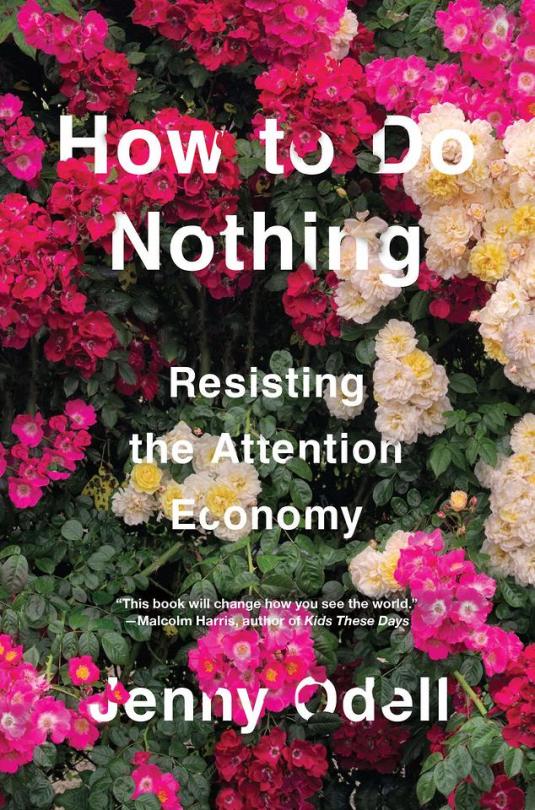
*wakes up and looks at phone* ah let’s see what fresh horrors await me on the fresh horrors device
–@MISSOKISTIC IN A TWEET ON NOVEMBER 10, 2016
--
A more recent project that acts in a similar spirit is Scott Polach’s Applause Encouraged, which happened at Cabrillo National Monument in San Diego in 2015. On a cliff overlooking the sea, forty-five minutes before the sunset, a greeter checked guests in to an area of foldout seats formally cordoned off with red rope. They were ushered to their seats and reminded not to take photos. They watched the sunset, and when it finished, they applauded. Refreshments were served afterward.
—
Bird-watching is the opposite of looking something up online.
--
They write: If you can have your time and work and live and be a person, then the question you’re faced with every day isn’t, Do I really have to go to work today? but, How do I contribute to this thing called life? What can I do today to benefit my family, my company, myself?
To me, “company” doesn’t belong in that sentence. Even if you love your job! Unless there’s something specifically about you or your job that requires it, there is nothing to be admired about being constantly connected, constantly potentially productive the second you open your eyes in the morning—and in my opinion, no one should accept this, not now, not ever.
--
Audre Lorde meant it in the 1980s, when she said that “[c]aring for myself is not self-indulgence, it is self preservation, and that is an act of political warfare.”
--
As Gabrielle Moss, author of Glop: Nontoxic, Expensive Ideas That Will Make You Look Ridiculous and Feel Pretentious (a book parodying goop, Gwyneth Paltrow’s high-priced wellness empire), put it: self-care “is poised to be wrenched away from activists and turned into an excuse to buy an expensive bath oil.”
--
Thinking about sensitivity reminds me of a monthlong artist residency I once attended with two other artists in an extremely remote location in the Sierra Nevada. There wasn’t much to do at night, so one of the artists and I would sometimes sit on the roof and watch the sunset. She was Catholic and from the Midwest; I’m sort of the quintessential California atheist. I have really fond memories of the languid, meandering conversations we had up there about science and religion. And what strikes me is that neither of us ever convinced the other—that wasn’t the point—but we listened to each other, and we did each come away different, with a more nuanced understanding of the other person’s position.
--
The life force is concerned with cyclicality, care, and regeneration; the death force sounds to me a lot like “disrupt.” Obviously, some amount of both is necessary, but one is routinely valorized, not to mention masculinized, while the other goes unrecognized because it has no part in “progress.”
--
Certain people would like to use technology to live longer, or forever. Ironically, this desire perfectly illustrates the death drive at play in the “Manifesto of Maintenance Art” (“separation, individuality, Avant-Garde par excellence; to follow one’s own path—do your own thing; dynamic change”)30. To such people I humbly propose a far more parsimonious way to live forever: to exit the trajectory of productive time, so that a single moment might open almost to infinity. As John Muir once said, “Longest is the life that contains the largest amount of time-effacing enjoyment.”
--
Poswolsky writes of their initial discovery: “I think we also found the answer to the universe, which was, quite simply: just spend more time with your friends.”
--
... he said, with an epiphany he had while accompanying a fellow clergyman on a trip to Louisville:
In Louisville, at the corner of Fourth and Walnut, in the center of the shopping district, I was suddenly overwhelmed with the realization that I loved all these people, that they were mine and I theirs, that we could not be alien to one another even though we were total strangers. It was like waking from a dream of separateness, of spurious self-isolation in a special world, the world of renunciation and supposed holiness.
--
My most-liked Facebook post of all time was an anti-Trump screed. In my opinion, this kind of hyper-accelerated expression on social media is not exactly helpful (not to mention the huge amount of value it produces for Facebook). It’s not a form of communication driven by reflection and reason, but rather a reaction driven by fear and anger.
Obviously these feelings are warranted, but their expression on social media so often feels like firecrackers setting off other firecrackers in a very small room that soon gets filled with smoke.
--
Our aimless and desperate expressions on these platforms don’t do much for us, but they are hugely lucrative for advertisers and social media companies, since what drives the machine is not the content of information but the rate of engagement. Meanwhile, media companies continue churning out deliberately incendiary takes, and we’re so quickly outraged by their headlines that we can’t even consider the option of not reading and sharing them.
--
To stand apart is to take the view of the outsider without leaving, always oriented toward what it is you would have left. It means not fleeing your enemy, but knowing your enemy, which turns out not to be the world—contemptus mundi—but the channels through which you encounter it day to day. It also means giving yourself the critical break that media cycles and narratives will not, allowing yourself to believe in another world while living in this one.
--
Standing apart represents the moment in which the desperate desire to leave (forever!) matures into a commitment to live in permanent refusal, where one already is, and to meet others in the common space of that refusal. This kind of resistance still manifests as participating, but participating in the “wrong way”: a way that undermines the authority of the hegemonic game and creates possibilities outside of it.
--
A crowded sidewalk is a good example: everyone is expected to continue moving forward. Tom Green poked at this convention when he performed “the Dead Guy,” on his Canadian public access TV show in the 1990s. Slowing his walk to a halt, he carefully lowered himself to the ground and lay facedown and stick-straight for an uncomfortable period of time. After quite a crowd had amassed, he got up, looked around, and nonchalantly walked away.
--
So to a question like “Will you or will you not participate as asked?” Diogenes would have answered something else entirely: “I will participate, but not as asked,” or, “I will stay, but I will be your gadfly.” This answer (or non-answer) is something I think of as producing what I’ll call a “third space”—an almost magical exit to another frame of reference. For someone who cannot otherwise live with the terms of her society, the third space can provide an important if unexpected harbor.
--
Herman Melville’s short story, “Bartleby, the Scrivener.” Bartleby, the clerk famous for repeating the phrase, “I would prefer not to,” uses a linguistic strategy to invalidate the requests of his boss. Not only does he not comply; he refuses the terms of the question itself.
--
Facebook abstention, like telling someone you grew up in a house with no TV, can all too easily appear to be taste or class related.
--
We need to be able to think across different time scales when the mediascape would have us think in twenty-four-hour (or shorter) cycles, to pause for consideration when clickbait would have us click, to risk unpopularity by searching for context when our Facebook feed is an outpouring of unchecked outrage and scapegoating, to closely study the ways that media and advertising play upon our emotions, to understand the algorithmic versions of ourselves that such forces have learned to manipulate, and to know when we are being guilted, threatened, and gaslighted into reactions that come not from will and reflection but from fear and anxiety.
--
“In short, when the inattention stimulus falls outside the area to which attention is paid, it is much less likely to capture attention and be seen,” the researchers write. That’s intuitive enough, but it gets more complicated. If the briefly flashing stimulus was outside the area of visual attention, but was something distinct like a smiley face or the person’s name, the subject would notice it after all.
--
As an artist interested in using art to influence and widen attention, I couldn’t help extrapolating the implications from visual attention to attention at large.
--
In a post about ad blockers on the University of Oxford’s “Practical Ethics” blog, the technology ethicist James Williams (of Time Well Spent) lays out the stakes: We experience the externalities of the attention economy in little drips, so we tend to describe them with words of mild bemusement like “annoying” or “distracting.” But this is a grave misreading of their nature. In the short term, distractions can keep us from doing the things we want to do. In the longer term, however, they can accumulate and keep us from living the lives we want to live, or, even worse, undermine our capacities for reflection and self-regulation, making it harder, in the words of Harry Frankfurt, to “want what we want to want.” Thus there are deep ethical implications lurking here for freedom, wellbeing, and even the integrity of the self.
--
In an effort to make the user aware of persuasive design, Nudget used overlays to call out and describe several of the persuasive design elements in the Facebook interface as the user encountered them. But the thesis is also useful simply as a catalog of the many forms of persuasive design—the kinds that behavioral scientists have been studying in advertising since the mid-twentieth century.
--
Vivrekar lists the strategies identified by researchers Marwell and Schmitt in 1967: “reward, punishment, positive expertise, negative expertise, liking/ingratiation, gifting/pre-giving, debt, aversive stimulation, moral appeal, positive self-feeling, negative self-feeling, positive altercasting, negative altercasting, positive esteem of others, and negative esteem of others.”
Vivrekar herself has study participants identify instances of persuasive design on the LinkedIn site and compiles a staggering list of 171 persuasive design techniques.
--
“knowing your enemy” when it comes to the attention economy. For example, one could draw parallels between the Nudget system, which teaches users to see the ways in which they are being persuaded, and the Prejudice Lab, which shows participants how bias guides their behavior.
--
Or that the woman in front of you in line who just screamed at you is maybe not usually like this; maybe she’s going through a rough time. Whether this is actually true isn’t the point. Just considering the possibility makes room for the lived realities of other people, whose depths are the same as your own. This is a marked departure from the self-centered “default setting,”
--
Last week, after a meeting, I took the F streetcar from Civic Center to the Ferry Building in San Francisco. It’s a notoriously slow, crowded, and halting route, especially in the middle of the day. This pace, added to my window seat, gave me a chance to look at the many faces of the people on Market Street with the same alienation as the slow scroll of Hockney’s Yorkshire Landscapes. Once I accepted the fact that each face I looked at (and I tried to look at each of them) was associated with an entire life—of birth, of childhood, of dreams and disappointments, of a universe of anxieties, hopes, grudges, and regrets totally distinct from mine—this slow scene became almost impossibly absorbing. As Hockney said: “There’s a lot to look at.” Even though I’ve lived in a city most of my adult life, in that moment I was floored by the density of life experience folded into a single city street.
--
When the language of advertising and personal branding enjoins you to “be yourself,” what it really means is “be more yourself,” where “yourself” is a consistent and recognizable pattern of habits, desires, and drives that can be more easily advertised to and appropriated, like units of capital.
--
In fact, I don’t know what a personal brand is other than a reliable, unchanging pattern of snap judgments: “I like this” and “I don’t like this,” with little room for ambiguity or contradiction.
--
The fact that commenting on the weather is a cliché of small talk is actually a profound reminder of this, since the weather is one of the only things we each know any other person must pay attention to.
--
(“bland enough to offend no one”)
--
The professional social media star, a person reverse-engineered from a formula of what is most palatable to everyone all the time.
--
Everybody says that there is no censorship on the internet, or at least only in part. But that is not true. Online censorship is applied through the excess of banal content that distracts people from serious or collective issues.
--
Our interactions become data collected by a company, and engagement goals are driven by advertising.
--
Mastodon... They allow more granular control of one’s intended audience; when you post to Mastodon, you can have the content’s visibility restricted to a single person, your followers, or your instance—or it can be public.
--
... forming any idea requires a combination of privacy and sharing. But this restraint is difficult when it comes to commercial social media, whose persuasive design collapses context within our very thought processes themselves by assuming we should share our thoughts right now—indeed, that we have an obligation to form our thoughts in public!
--
A counterexample would be the sparse UX of Patchwork, a social networking platform that runs on Scuttlebutt. Scuttlebutt is a sort of global mesh network that can go without servers, ISPs, or even Internet connection (if you have a USB stick handy). It can do that because it relies on individual users’ computers as the servers, similar to local mesh networks, and because your “account” on a Scuttlebutt-powered social media platform is simply an encrypted block of data that you keep on your computer.
--
In #NeverAgain, David Hogg writes that “[a]nger will get you started but it won’t keep you going.”
--
Before long, the conference would be over, and I would have missed most of it. A lot of things would have happened there that are important and useful. For my part, I wouldn’t have much to show for my “time well spent”—no pithy lines to tweet, no new connections, no new followers. I might only tell one or two other people about my observations and the things I learned. Otherwise, I’d simply store them away, like seeds that might grow some other day if I’m lucky.
--
Seen from the point of view of forward-pressing, productive time, this behavior would appear delinquent. I’d look like a dropout. But from the point of view of the place, I’d look like someone who was finally paying it attention. And from the point of view of myself, the person actually experiencing my life, and to whom I will ultimately answer when I die—I would know that I spent that day on Earth.
--
“I would prefer not to.”
0 notes
Text
Iron Man (2008) Review
To kick off this re watch and individual review of each film in the Marvel Cinematic Universe we must of course start at that humble beginning that is so cherished by the fans of this franchise: Iron Man. I'm sure it won't surprise anyone to hear that I have seen this movie many times, so I did have some preconceived notions and feelings towards it before this viewing. I still tried to dive back in as unbiased as possible with the mindset of a new viewer. While some opinions have developed further during this latest watch, I find it leaves a similar impression on me no matter how many times I see it. It’s still a fresh take on the super-hero genre that is full of entertaining performances, great dialogue and a fun edge. Even with all the charm Iron Man has to offer, though, its crowning achievement is introducing the world to Tony Stark, who is easily one of the best written and performed characters I have seen in a long running franchise. This is his origin story, and though we have seen a lot of those throughout the years you would be hard pressed to find one executed this well.
I would describe Marvel Studios' Iron Man as a "risk that was played safe". Iron Man was far from a household name before 2008, and while it turned out that his origin adapted well into film, choosing him was risky in itself when the "A-listers" (Superman, Batman, Spider-Man, ect.) had until then dominated cinema. Jon Favreau’s unique style of humor was also a venturesome choice in the superhero genre. However, by sticking to what I believe to be relatively safe story structures as a base, the tone of the movie was able to hit the right chords and as a result Iron Man himself became an “A-lister”. On paper, though, other than rightfully avoiding some common tropes of the genre, the full plot is moderately formulaic. It is the story of a man and the dire circumstances that put fantastic abilities into his hands, forcing him to gain a new moral outlook. With this sense of what is right he uses his “powers” to do good in the world, and ultimately he must face a villain with opposite ideals and unnatural strengths of his own. Obviously these are only the most bare story beats, but they still follow a structure that we are familiar with. So how does such a standard story end up feeling fresh and inventive? Part of the credit must go to Favreau, who took his one of a kind style and blended it into a fun action film. There may be the occasional rough moment in the flow and overall tone of Iron Man, but it’s only natural considering Favreau was working in a genre that was unfamiliar to him. I also found that these moments were few and far between, and noticeable only when paying close attention. Even catching the rare tonal issue, it still doesn’t really detract from the film’s entertainment. Plus it was more than worth it to have Jon Favreau’s particular flare to a movie like this. It is that very style, along with the excellently written characters, that made Iron Man special. That is, of course, along with the undeniable talent of Robert Downey Jr.
When a story follows such a basic formula, even when does so very well as it does here, one of the best ways for a movie to really shine is to focus on strong characters. That is a strength that this motion picture definitely has. The best example of this is undoubtedly Robert Downey Jr.'s portrayal of Tony Stark. Stark has some cool qualities in the comic book stories he originated from- he is a genius, he is incredibly wealthy, and he is a total playboy- there's even some great development later on from what I can tell (though I haven't read very much), notably his use of alcohol to cope with the problems he faces. Despite having a lot of interesting characteristics on the surface, I feel like the character is still missing something in the source material, at least earlier on. For some reason he is still hard to connect with. The cocky, witty, and larger than life persona that Downey brings to the role does a lot to fill that hole in the cinematic franchise, but what truly makes the film version of Tony Stark so compelling is easily Downey's believable performance throughout the strong character arc that was written for him. Tony finally seeing his legacy from the other, darker side of the spectrum is definitely written effectively; but it is the actor's ability to convey his newfound sense of what is right, along with his disillusionment with the life he had before that is truly great.
There was a character that I actually enjoyed a lot more than I remembered during this watch, as well, and that would be Pepper Potts. Personally, I've always liked her relationship with Tony Stark, but her character isn’t given very much growth or development in the first Iron Man. That’s how I feel, anyway, and that is probably why her part in the movie wasn’t one of the main things I remembered. However, despite not having a ton of depth in this movie I don't find her to be poorly written, either. I also found Gwyneth Paltrow’s performance to be pretty enjoyable this time around, too. I especially enjoyed the chemistry between her and Downey, their back and forth being one of the aspects of the movie I liked the most. I was very much invested emotionally in the scenes they shared, and I look forward to seeing their development in future movies as I continue my re watch.
Yet on the other side of the coin is another important character who unfortunately is not a highlight of the story: Obidiah Stane. The character is not exactly weak, and works relatively well in the first two acts. Jeff Bridges also does fine work with what he was given. As he predictably shifts into the feature villain, though, he seems increasingly two-dimensional, cheesy, and ineffective. As we all know, this trend became a recurring problem in the earlier entries of the MCU; an underdeveloped villain with bland abilities who exists mainly to be a source of conflict. This very well could have been deliberate seeing as the heroes are obviously the spotlight in this series, and for this film having a very standard villain that embodies the opposite of Stark’s growth does work... but honestly his role “working” is about the most that can be said for his contribution to the movie. The deepest part of the character is how he represent's Tony's past, other than that he's just an asshole with a bigger suit.
Before I move on from the characters, I do want to mention a couple of the smaller characters who had an impact on the film. The first being Yinsen, the man in the cave with Tony. The beginning of their relationship admittedly felt a little forced, but they did have a few nice moments as they worked together that felt genuine to me. I'm glad that there are some effective scenes to keep me invested in their relationship, because at times he does unfortunately seem to only be there for the plot and for Tony’s development. His death in particular felt forced to me, and even though his reasons for his self-sacrifice weren't too much of a stretch, the scene just came off as an attempt to add some quick drama to the journey that Tony had started. It may feel a little contrived but that feeling is short lived, and the moment is not over-done, at least. Overall the character does serve the film’s narrative and is obviously an important part of Stark’s life.
Other than Yinsen I really wanted to comment on Phil Coulson because... well honestly because I just love him so much. Coulson's role in the movie has its importance, but it is still a pretty small part. The fact that he is so memorable just goes to show you awesome Clark Gregg is as an actor; he has such great chemistry with everyone he interacts with, and his character is a great way of serving the individual story while simultaneously setting up S.H.I.E.L.D. for the Marvel universe. Ultimately, Gregg utilizes a great balance of humor and mystery to convey the next-level "importance" of the organization. In my notes for this re watch, my exact wording is "Phil Coulson is a treasure" and I feel like that's all I need to say.
While the basic story is not the highlight here, there are some things that it executes splendidly. It handles the underlying themes of Tony Stark's path from war-profiteer to hero with great care, not only showing more ugly sides to war but also making it easy for the viewer to understand how Stark thinks and feels both before and after he is abducted. The first Iron Man film also tells what I believe to be the perfect origin story. It does this with a surprisingly effective utilization of pacing, starting with the very first scene. I love the opening minutes, and all they do is use dialogue to give us our first taste of who Stark is. Then we are immediately thrown into the action with the abrupt ambush that leads to his capture. That’s when the story pulls back to give us his history and show us a little more of his character, and having already invested the viewer in the story it very quickly gives us all we need to know going forward. I do typically dislike when a movie starts off with a bang then goes back in time to give us more information that we need, because it can get tedious when we really want to see what happens after the opening action. This is not a big issue here, though, as the pacing is very quick and the movie is still in its early phases when we get back to the initial conflict. We are only "taken back" to show us what is absolutely crucial to know, and it doesn't drag on too long or come off feeling forced.
After Stark’s thrilling escape sequence, he is free from the cave to return home, and we move into the second act... which is the best part of the film. Downey's performance is at its peak during the upheaval of Tony Stark’s original life, and the characters have all of their best interactions during this portion of the movie. For a story that primarily focuses on characters, this is definitely some of the most entertaining material. The third act is, unfortunately, the weakest one, as it has the job of turning Stane into the villain and ultimate climax of the movie. Stane's actions as a villain feel forced, especially his actions that lead to the creation of his suit. Even his final fight with Iron Man just feels like it's happening for the sake of having a "big fight" at the end. Stane's dialogue is a little cheesy, and there are moments where things seem to happen just so that there can be more tension and conflict- specifically when Stark is on the ground helpless and Stane keeps missing his shots by a lot. He even has some throwaway line that goes something like "you ruined my targeting system but I'll still kill you". Not an exact quote but it had that awkward feeling of just being written to give us a reason why the hero is being given more time to act in such tense situation. In the end Stane is a weak villain, and when the movie has to focus on him it is not at its best. However, the wrap up and conclusion of the film that comes after this fight is amazing and pretty much makes up for it. It manages to sum up the story that was being told and remind you of the things that made you enjoy it in the first place. The scene where Tony Stark admits to being Iron Man in front of the press is rightfully loved for being a very cool moment for Tony Stark/Iron Man, but it is also a brilliant ending to an origin story. By definition we are getting the story of how Iron Man came to be, it is very fitting that the movie ends at the moment he is truly "born".
CONCLUSION:
Despite Favreau's slight inexperience with the genre, a fairly weaker climax/villain and a few moments that feel like they exist solely to move the plot forward, Iron Man succeeds with an entertaining and unique style accompanied by an absolutely stellar performance by Robert Downey Jr.- and the result is a very fun watch. The cinematography is on point, featuring a few shots that will remain truly iconic... I particularly love the shot of Tony presenting his missiles as they explode behind him, not to mention almost every second of the first time Tony suits up and uses Iron Man to undo the damage done by his company. The score composed for the film also adds what it needs to, and some of the song choices will pretty much make you to get pumped up. This is why a standard origin story for a comic book hero can make you forget that you know where the story is going... if done right, there are so many inventive ways to tell that story with a different voice. Is this the best movie ever? No. Is it the best Marvel film? The answer for me is still no. That said, it was a great stand alone movie, an even better origin story, and set up a universe so subtly that upon first viewing you didn't even notice that it did anything of the sort. The fact that the world building was done in the background made the post credit scene that teased the Avengers so much better. You had no idea how great an established universe around this movie would be, but when you see that it could happen you suddenly realize how much you want one. Iron Man is not a masterpiece of cinema, nor does it try to be. It was just one hell of a fun ride that not only launched what is arguably the biggest film franchise of all time, it also gave us a fresh new look at the tired superhero genre and redefined our expectations of it going forward.
RATING: 7.5
Next: The Incredible Hulk
0 notes
Text
Sophia Amoruso on Life After Nasty Gal and How Her Definition of a ‘Girlboss’ Has Changed
Shoppers Drug Mart is gearing up for another Be Bold with Beauty campaign and who better to get involved than Sophia Amoruso? At just 22 years old, she was already taking her first steps towards creating an empire, transforming an eBay store of vintage finds into the ultimate online treasure trove for cool girls, Nasty Gal.
The metamorphosis between the two domains was pretty swift, earning the young businesswoman names like the “Cinderella of tech” and a spot on Inc. Magazines‘ 30 under 30 list. In fact, Forbes even named her one of the richest self-made women in the world. But the skyrocketing speed at which Nasty Gal was born ultimately ended with bankruptcy in 2016.
Now, at 34 years old Amoruso has refused to be buried, carrying on in the face of adversity and charting a new course focused on Girlboss Media, her new company. A lot has changed since she wrote her New York Times bestseller. In fact, her whole definition of what it means to be a “girlboss” has changed. We sit down with Amoruso to chat about how change isn’t always a bad thing—whether it be in life, in your career or simply in your beauty routine.
Why do you think you’re a good fit for Shoppers Drug Mart’s Be Bold with Beauty Campaign?
I’ve always been bold in my career and I’ve had a very loud career. I mean, there’s a Netflix show made about my life, which is crazy. And Nasty Gal, even though I’m not involved anymore, was bold. About as bold as you can get.
I still consider myself bold in my style and in my beauty looks, but I have a little more restraint now when I choose a lip or an eye and maybe don’t layer leather on leather on platforms. I don’t just dump jewellery on myself now. So it’s been nice to have this evolution and it’s important for me and for Girlboss, which is my new company, to encourage women to be bold and to get out there and demand what they’re worth and to discover themselves by trying new things and taking action.
So obviously we know that you’ve always been into fashion, but have you always been into beauty?
I think I’ve always worn makeup. From the time I was 11 I was sneaking mascara onto my face at school. I had no idea what beauty meant, I called it makeup. And I had my compact and I powdered my stinky compact on my face and you know, thought that that was what I should be doing. Beauty has become a lot more sophisticated. There’s so much more education online on what products the pros are using and how to apply them and not look like a clown, which is very easy to do! You’re putting colour on your face! Especially living in Los Angeles; it’s a place that will teach you about personal hygiene like no other.
The campaign’s goal is really to get people stepping out of their comfort zone. Talk to me about a time you did that.
Every day I step out of my comfort zone and it’s in small ways. It’s in the ways that everybody experiences every day. It’s in showing up and doing the job that I know I’m supposed to and wondering if I’m qualified—which we all probably do every day no matter how much experience we have.
I think making the transition from Nasty Gal to Girlboss, I mean it was almost immediate… I didn’t stop or take a break. That was a bold move and people were just shocked that I kept going and were like, “You’re so resilient” but I just kept going. It’s not that hard to do if you just do it, even though it’s way scarier doing it after having such public successes and setbacks as an entrepreneur. But Girlboss is too important to me to just sit on and it feels like it’s my purpose and that makes it an easy thing to do.
So how did you come up with the idea for Girlboss?
I wrote the book while I was building my fashion business in my 20s—I started it when I was 22 years old. I was in it for ten years and it was in 2014 that it kind of took on a life of its own. I really wanted to write a business book that would be the gateway drug for a girl who maybe didn’t have the pedigree of most of the women who were writing books. I’m a community college drop out and I shouldn’t be qualified to run a business… and I’m probably not. But who is? And I wanted to inject a sense of fun and humour into a business book. And I wanted it to be a relatable way for a generation of women who are unlikely entrepreneurs like myself, who have all the digital tools at their disposal, to take risks and be bold and be entrepreneurial, whether on the inside of a company or starting something from the ground up.
Girlboss shares a lot of articles and stories, but what makes it different from, say, a traditional media outlet?
I mean digitally, we’re not really selling banners and boxes. All of the work that we do with brands is with brands we feel strongly about. And programs that we do with those people and those brands all create value for our user, for our community, for ourselves and for them. So we’re using the powers that be to bring education and utility and connections to women that may not have them otherwise. And we’re sharing content that isn’t news–there’s plenty of news out there–we’re sharing content that can really, very incrementally, inspire and educate our audience on how to make small steps in their lives, whether it’s saving a little bit more money or asking for that raise they know they deserve.
And I know you also do meet ups…
Yeah, the Girlboss Rally!
You just had one in April. Can you tell me a bit more about those events?
So we’ve done three Girlboss Rallies. It’s a conference. We had 800 women at the Los Angeles rally in April, we’ll have more at the New York rally in November and we generally have around 50 speakers. Everyone from Gwyneth Paltrow, to Sallie Krawcheck, to Ashley Graham, to Elaine Welteroth have all spoken and it’s a way for the community that, you know, has read Girlboss, is subscribed to our email list, who is inspired by what we’re doing to meet one another. And content aside, what happens on that stage is one small part of what happens there. It’s really about finding community and meeting maybe your next co-founder in a way that’s maybe hard to do online. And long term we want to figure out a way to bring that online and for women to make those bold moves to meet one another and level up their game.
Where do you see Girlboss going in the future? Do you see it developing further?
I think the digital piece of what we’re doing is more infinitely more scalable than a conference or editorial, which is limited to the number of editors that we can employ. So it’s creating a place where our community is creating content for one another and sharing their learnings, because what they know is as important as what we have to share and there is so much more to share when you bring like-minded women together.
In the future do you ever see yourself revisiting something like Nasty Gal?
I think maybe I would go into fashion. It won’t be any time soon. I mean, I love fashion and I’m sure we’ll work with fashion brands in the future, but it’s been nice to take a break. Our inventory is also infinitely scalable if you think about what it is that we’re selling. It doesn’t have to be in a warehouse and it doesn’t have to go on sale and you can’t ship it late and you don’t get returns and the things that were the bane of my existence for a decade. Retail is really hard. And it’s a difficult time for fashion to feel important, even though it is, but there’s so much going on in the world… focusing on Girlboss right now feels really good.
Do you miss any part of it?
I do miss making products. I miss the physical part of it. I pay way less attention to fashion, but I do miss it. Whatever it would be, I do want to get into commerce again eventually.
Do you think your definition of being a girlboss has changed since you first coined the term?
Yeah, I think it’s evolved and it’s a little more complex now. It’s taking into account everything that’s happening in the world and in culture and in representation. I had a very small view of the world; it was a different time. At the time, just saying “badass” was all you needed to do and now “badass” just feels really played out. And so I’ve evolved, I’ve become more sophisticated. You know, I was quote-on-quote winning when I wrote that book and a lot has changed since then and a lot of the advice I gave I wouldn’t necessarily agree with today. I hope that everyone who reads that, and who gets any advice from anybody, throws half of it away and remembers that the experience of people giving you advice and what you know about yourself and what’s right for you are very different things. It may always work for them but it doesn’t mean it will always work for you.
Why do you think the beauty industry is booming right now?
Oh my god, it’s massive! I’d say that there’s a very underserved market in beauty. It’s become a lot more inclusive. The legacy powers that be are finding themselves scrambling to innovate as more and more companies have access to social media to build their businesses. Urban Decay is an example of that. They’ve just built a massive business. And there’s a rise in clean beauty. I love RMS, I use it every day. I think fashion has become a lot more subltle and conservative and beauty is still something we can take a lot more risks with and be a lot more bold with.
You mentioned RMS, what are some of your other favourite brands?
For mouisturizer I use Emryolisse. I love Bioderma, just finishing up my cleansing with that. I love Chanel’s foundations. Guerlain feels very cool and classic. I don’t know how to say it… I think everyone here can say it in a more French way than I can. And I mean Nars is tried and true, the best pigments around…
So what’s your every day look?
I use anything in a pot. Anything that’s a cream. I like using my fingers. I don’t think I’m necessarily an expert at it, but I kind of don’t care. And like a simple eye with a bold red lip. You can wear it with denim, you can wear it with all black and you just look cool.
Nothing says girlboss like a red lip…
I know, I know… I’ve definitely carried that over from Nasty Gal.
0 notes